|

Here you'll find articles about museums that feature exhibitions on
antiques and collectibles.
LATEST MUSEUM__________________________________________
Yuletide at
Winterthur Museum
by Bob
Brooke
"Deck the Halls" must surely have
been written with Winterthur Museum's Yuletide Tour in mind. Though
today Christmas has become a rather formula holiday, America's
forefathers celebrated it in many creative ways. While Winterthur is
magical any time of the year, it’s especially so during the
holidays.
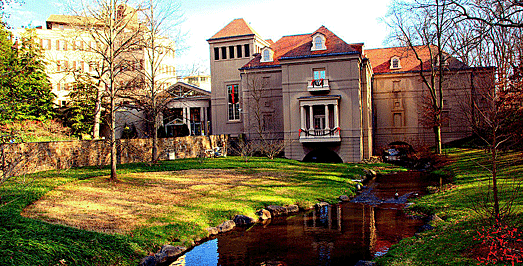
Each year, the staff of the country
estate of the late Henry Francis duPont near Wilmington, Delaware,
transforms the museum into a holiday wonderland. The museum, which
houses over 89,000 objects of American decorative arts, takes on a
special feeling, one that would even put old Scrooge, himself, in a
happy holiday mood.
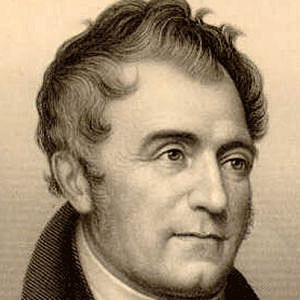 n
the early 20th century, H. F. duPont and his father, Henry Algernon duPont, designed Winterthur in the spirit of 18th- and 19th-century
European country houses. The younger duPont added to the home many
times thereafter, increasing its number of rooms to six times the
original. After he established the main building as a public museum in
1951, DuPont moved to a smaller building on the estate. n
the early 20th century, H. F. duPont and his father, Henry Algernon duPont, designed Winterthur in the spirit of 18th- and 19th-century
European country houses. The younger duPont added to the home many
times thereafter, increasing its number of rooms to six times the
original. After he established the main building as a public museum in
1951, DuPont moved to a smaller building on the estate.
Initially a collector of European art and decorative arts in the late
1920s, H. F. duPont became interested in American art and antiques.
Subsequently, he became a prominent collector of American decorative
arts. Today, Winterthur houses one of the country’s most important
collections of Americana, spanning more than 200 years, from 1640 to
1860.
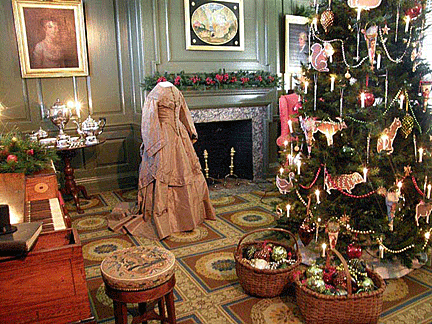 Twenty-two
room settings—out of 175 bedrooms, parlors, dining rooms and drawing
rooms—come alive with vignettes of Christmas Past, each recreated using
priceless antiques and decorated to recreate the holiday charm of 18th
and 19th-century America. These aren't merely static museum exhibitions
but carefully researched scenes, depicting special aspects of the
holiday season. Each has a lived-in look so that when entered, looks as
if the guests have just stepped out for moment. Using actual letters,
newspaper accounts, paintings and etchings of the times, the staff
strives for realistic representations of holiday traditions. Twenty-two
room settings—out of 175 bedrooms, parlors, dining rooms and drawing
rooms—come alive with vignettes of Christmas Past, each recreated using
priceless antiques and decorated to recreate the holiday charm of 18th
and 19th-century America. These aren't merely static museum exhibitions
but carefully researched scenes, depicting special aspects of the
holiday season. Each has a lived-in look so that when entered, looks as
if the guests have just stepped out for moment. Using actual letters,
newspaper accounts, paintings and etchings of the times, the staff
strives for realistic representations of holiday traditions.
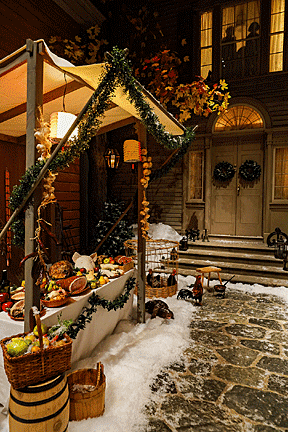 As
the pipe organ strains of "O Come All Ye Faithful" rise in the
background, the tour begins in an unusual indoor snow-filled courtyard
duPont created from the facades of colonial houses and a tavern that he
had installed along the walls of his former badminton court. Take a peek
into the Red Lion Inn to see the games that guests played in the bar.
Why not a round of backgammon? As
the pipe organ strains of "O Come All Ye Faithful" rise in the
background, the tour begins in an unusual indoor snow-filled courtyard
duPont created from the facades of colonial houses and a tavern that he
had installed along the walls of his former badminton court. Take a peek
into the Red Lion Inn to see the games that guests played in the bar.
Why not a round of backgammon?
This year's Yuletide Tour highlights the holidays through the eyes of
children. The centerpiece is the museum’s new 18-room dollhouse mansion
charmingly decorated for Christmas and filled with more than 1,000
treasures. Interior decorator and collector Nancy B. McDaniel lovingly
assembled the 6-foot-by-3-foot, slate-roofed, fully-electrified
dollhouse, inspired by Queen Mary's Dolls' House, over 30 years and gave
it to the museum in 2015.
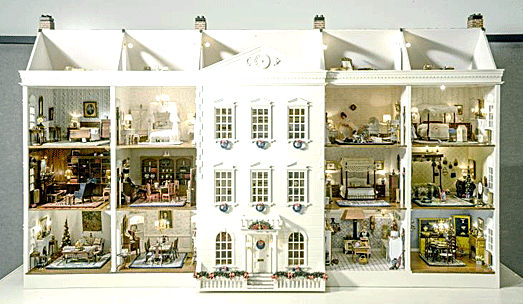
In addition to this miniature
masterpiece, you can also view vignettes of American Christmas
traditions, from skating and sleigh ride scenes inspired by the work of
Currier & Ives to a Mississippi family's holiday decorations on the eve
of the Civil War to the White House in the early 20th century.
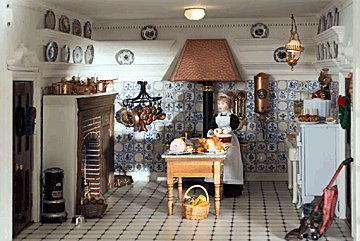 The
Yuletide tour changes every year but usually includes the same types of
displays arranged in different rooms. In the past, the tour has featured
everything from a New Orleans reveillon to New Year's Day mumming and
several versions of Santa Claus. The
Yuletide tour changes every year but usually includes the same types of
displays arranged in different rooms. In the past, the tour has featured
everything from a New Orleans reveillon to New Year's Day mumming and
several versions of Santa Claus.
The Federal style duPont Dining Room has been the setting for an adult
party. The men have stayed after dinner to drink and talk and the women
have retired to the Drawing Room to sew. The scene comes complete with
nut shells and crumbs on the floor.
The Baltimore Dining Room was the setting of an elaborate New Year's Day
calling celebration. It was the custom in early America for gentlemen to
call on all their friends and business associates on New Year's Day. The
tables were laden with sweets and the liquers line the liquor cabinet.
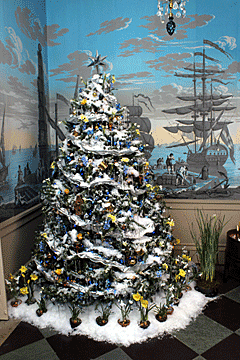 Visitors
also see one of several Christmas trees in the Chinese Parlor, an
elegant and elaborate room lined with handmade Chinese wallpaper from
1770. Visitors
also see one of several Christmas trees in the Chinese Parlor, an
elegant and elaborate room lined with handmade Chinese wallpaper from
1770.
To honor the French Revolution, the Empire Parlor has been set for a New
Orlean's reveillon, an elegant late-night meal served after midnight
mass on Christmas Eve. The table overflowed with oysters and pastry
puffs filled with shrimp paste. In the corner stood a small table for
the children laden with marzipan and cookies.
In addition, the Conservatory at Winterthur has been made into an
orangery, filled with exotic fruit trees and plants in the French
tradition.
One of the most popular displays has been the scene in a Hudson River
Valley home, where a Dutch family celebrated the holiday on St. Nicholas
Eve. Stockings hung by the chimney with care and children's shoes,
waiting to be filled by St. Nicholas, sit in front of the fireplace.
Other displays have included a Twelfth Night party in the Chippendale
Dining Room, complete with a house of cards and a lavish buffet, a hunt
breakfast, and a gentleman's drinking party with glasses of wine,
playing cards and backgammon.
"Deck the halls with boughs of holly," and other greens as the tour
continues through a German drawing room complete with cut-out cookies
hanging in the windows and a putz around the tree.
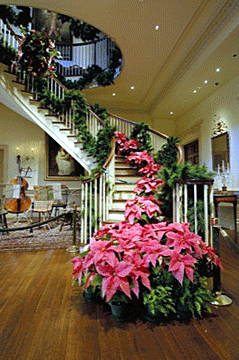 Chinese
exports also often included exotic plants. Camellias and roses were
among those imported to America. Imagine a sea captain returning home in
cold December with flowering presents for his family. Chinese
exports also often included exotic plants. Camellias and roses were
among those imported to America. Imagine a sea captain returning home in
cold December with flowering presents for his family.
The staff at Winterthur has even gone all out in recreating a scene
depicting a 1779 Thanksgiving dinner in New England in the Marlboro
Room. The first declared "Thanksgiving" in America occurred in 1623
after a providential shower saved the
crops. They based this Thanksgiving vignette on a letter from Juliana
Smith to a cousin. Despite hardships and deprivations of the
Revolutionary War, the family dined on venison, pork, turkey, goose and
pigeon, as well as something new called "Sellery" which guests could eat
without cooking.
Winterthur's Federal style duPont Dining Room became the setting for a
lively White House children's party. Children gather round to hear a
reading of Clement C. Moore's "A Visit from St. Nicholas." Afterwards,
they have an indoor "snowball" fight.
A gala winter ball once took over the Port Royal Parlor. Imagine the
ladies in their finery coyly fluttering their fans to attract a
gentleman's attention. Dolly Madison played hostess to many a card
party. The staff re-created one of her parties, complete with Dolly's
own table and little mother-of-pearl fish markers.
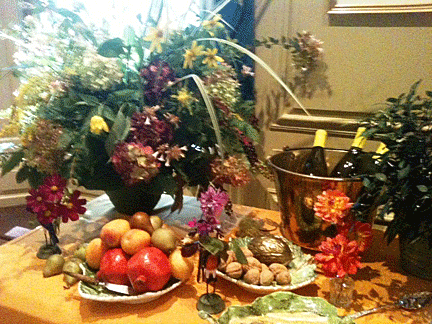 Another
exotic import to the United States was the tradition of Mardi Gras. The
Carnival tradition of the "bal du Roi," or King's Ball, is a fascinating
mixture of Spanish and French customs. Celebrated on January 6th, or
Twelfth Night, this event inaugurated the season of festivities that
continued through Mardi Gras, or Shrove Tuesday. One year a lavish
King's Ball occupied the Empire Parlor, complete with a sweet-bread
Twelfth Night cake. Another
exotic import to the United States was the tradition of Mardi Gras. The
Carnival tradition of the "bal du Roi," or King's Ball, is a fascinating
mixture of Spanish and French customs. Celebrated on January 6th, or
Twelfth Night, this event inaugurated the season of festivities that
continued through Mardi Gras, or Shrove Tuesday. One year a lavish
King's Ball occupied the Empire Parlor, complete with a sweet-bread
Twelfth Night cake.
Another Yuletide vignette featured a setting of an American family
reading Charles Dickens' A CHRISTMAS CAROL. Published in 1843, the book
was responsible for popularizing Christmas as a time of charitable
giving. The staff created the setting in the Georgian Dining for a
Victorian family—the father reading the classic story, the mother sewing
and the children playing with toys. In fact, the children have arranged
their doll furniture to recreate scenes from the story, including
Scrooge's bedchamber and office and the Cratchit's Christmas dinner.
The Conservatory, where the duPont's traditionally had their tree, has
often featured the huge, ethereal March Bank spruce tree bedecked with
dried flowers raised in the gardens of the estate.
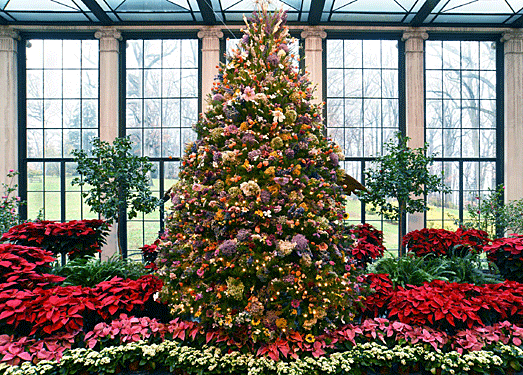
One of the most lavish displays ever presented on the Yuletide tour was
a 17th-century Old English Christmas dinner. The dinner, as described by
Charles Dickens, featured a Boar's head, Cornish game hens, plum
pudding, oysters, and desserts.
Other favorites have included an 1850 holiday celebration of Swedish
Nightingale Jenny Lind, in America for a concert tour and a dance in
Philadelphia's City Tavern during the 1777-1778 British occupation of
the town. Another vignette depicts a 19th-century family celebrating
Hanukkah, featuring a collection of colonial minoras and a hand-carved
ivory and cinnabar chess set.
Yuletide at Winterthur attracts thousands of visitors annually. Although
pre-paid reservations are required for the one-hour tour, visitors
needn't arrive more than 15 minutes before to pick up their tickets at
the Visitor Pavilion. From there, they’re transported by free shuttle
buses to the main entrance to begin their tour.
<
Back to More Antiques to View
|
